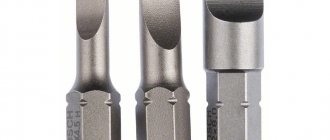Hello readers of seoslim.ru! The inch (inch) is a unit of measurement with a long history. Its name is derived from the Dutch word meaning thumb.
Before the widespread introduction of the metric system, such a unit was used throughout Europe, including in Russia (it was introduced by Peter I), and the meaning varied in each country.
Nowadays the English inch is used, for example in the USA, Great Britain and Canada it is used in everyday life.
In other countries, inchi is used to measure technical parameters.
Inch designation
In technical documentation, three inch designations are accepted:
- Inch;
- In;
- ’’.
These are international designations that are used in all countries.
The last character ( '' ) is the most common - it does not cause discrepancies, it cannot be mistaken for any other. The designation Inch or In is more common in English-speaking countries.
In the metric system, inch is not used and therefore has no designation. It is also impossible to form fractional or multiple units (microinch or kiloinch) from it.
The International Organization of Legal Metrology, which sets global standards for units of measurement, calls for the inch to be abandoned in everyday life. But in industry, including the arms industry, this unit of measurement is so ingrained that switching to centimeters and millimeters will be extremely inconvenient.
On the subject: How to convert GB to MB, KB to MB, bits to bytes
In Russia, inch is allowed to be used only in industry. The accepted notation is '' . Example, TV diagonal is 32'' .
What is 1 inch in centimeters and millimeters?
An English inch is equal to 2.54 cm or 254 mm.
These units measure:
- Diagonals of screens on TVs, monitors, smartphones;
- Weapon calibers;
- Diameter of wheels and tires in a car;
- The diameter of the objective and lenses in a telescope;
- Arrow length for sport shooting;
- Floppy disk size.
In this capacity, the inch is used in all countries, including Russia.
What is the diagonal of a smartphone
The phone screen diagonal is the distance from the bottom left corner to the top right corner. It's quite easy to measure. And anyone with a ruler can do it. The diagonal is indicated in inches. This is because the first devices with screens – televisions – appeared in the USA. And there the so-called “imperial” system of measures was adopted. It is also called English.
How to find out the diagonal of a smartphone in centimeters
To convert inches to centimeters, multiply the diagonal value by 2.54. 1 inch = 2.54 cm or centimeters. For example. If the screen diagonal is 6.2', then in centimeters it will be 6.2 * 2.54 = 15.75 cm.
What is the difference between screen resolution and diagonal
Read more about screen resolution here. In short, the resolution of a smartphone is the number of pixels along the X-axis and Y-axis. For example, 720x1280 pixels.
As you can see, the diagonal tells us about the size of the screen itself. While resolution is how many pixels are on the screen. The more there are, the clearer and more detailed the picture will be. The smaller, the more “grainy” the screen will be.
That is why in the characteristics of smartphones there is still such a thing as pixel density. This is the number of pixels that fit in one inch of a device's screen.
It turns out that the larger the screen diagonal, the higher the resolution should be. This is when the pixel density will be acceptable. For example, a smartphone screen with a diagonal of 5.5 inches and a resolution of 720*1280 pixels will be better in quality than a 6.2-inch screen with the same resolution. This is because in the first case there will be more pixels for every inch of the screen.
What are the diagonals of smartphone screens?
According to Deviceatlas.com, in the first half of 2021, the most popular smartphone diagonals in the hands of users around the world were still 5.5 and 4.7 inches. And this despite the fact that in 2019, a rare manufacturer released models smaller than 5.8 inches onto the market. It seems that in 2021, the first place will be taken by phones with screens from 5.8'.
The maximum smartphone screen size can be considered 6.7 inches. Phones with such screens are also called phablets. Anything larger is already a tablet.
What is the viewing area (viewport) of a smartphone screen
The term “viewport” was coined so that website and application creators could create highly readable and distinguishable elements on any smartphone.
In fact, this is a trick that allows smartphone manufacturers to write beautiful resolution numbers, such as Full HD (1280x1920 pixels), etc. But in fact, in a browser or application in real life, much lower values are used - 414x736. Do you feel the difference?
The viewport makes websites appear differently on mobile devices than they do on a desktop screen. Users don't have to zoom in to see small text and buttons. Thus, the viewing area of a smartphone screen means a resolution at which it will be convenient to view websites or application interfaces.
An example of the relationship between viewing area, resolution and diagonal of iPhone screens:
| Model | View area | Permission | Diagonal | PPI |
| iPhone XR | 414×896 | 828×1792 | 6.1″ | 326 |
| iPhone XS Max | 414×896 | 1242×2688 | 6.5″ | 458 |
| iPhone XS | 375×812 | 1125×2436 | 5.8″ | 458 |
| iPhone X | 375×812 | 1125×2436 | 5.8″ | 463 |
| iPhone 8 Plus | 414×736 | 1080×1920 | 5.5″ | 401 |
| iPhone 8 | 375×667 | 750×1334 | 4.7″ | 326 |
| iPhone 7 Plus | 414×736 | 1080×1920 | 5.5″ | 401 |
| iPhone 7 | 375×667 | 750×1334 | 4.7″ | 326 |
| iPhone 6S Plus | 414×736 | 1080×1920 | 5.5″ | 401 |
| iPhone 6S | 375×667 | 750×1334 | 4.7″ | 326 |
| iPhone 6 | 375×667 | 750×1334 | 4.7″ | 326 |
How to convert inches to centimeters + table
To convert the value indicated in inches to centimeters, you need to multiply it by 2.54.
It's difficult to do this in your head. If accuracy is not important, you can multiply the value by 2.5, but this creates a serious error.
This method is suitable when it comes to a work of art, but it is completely unsuitable when you need to choose a TV for the wall or a part for a car and not make a mistake with the size.
For this case it is convenient to use the table:
| 1’’ | 2.54 cm | 25.4 mm |
| 2’’ | 5.08 cm | 50.8 mm |
| 3’’ | 7.62 cm | 76.2 mm |
| 4’’ | 10.16 cm | 101.6 mm |
| 5’’ | 12.7 cm | 127 mm |
| 6’’ | 15.24 cm | 152.4 mm |
| 7’’ | 17.78 cm | 177.8 mm |
| 8’’ | 20.32 cm | 203.2 mm |
| 9’’ | 22.86 cm | 228.6 mm |
| 10’’ | 25.4 cm | 254 mm |
TV aspect ratio 50″
At first glance, it doesn't cost anything to do arithmetic calculations. A value of 1 inch is equal to 2.54 centimeters. Multiplying the standard figure by 50″ indicated in the original data, we get 127 cm. This is exactly the size of the diagonal.
TV inches
However, if you need the height and width of the device you are purchasing, you should take care to obtain information about the aspect ratio. And for different types of TV it comes in several versions - 4:3, 16:10 and 16:9. This is only the norm, and the released TV may be somewhat non-standard. The width in the calculations will be different:
- 4:3 – 101.6 cm;
- 16:9 – 110.69 cm;
- 16:10 – 107.7 cm.
Conversion of fractional inches
Sometimes fractional fractions of an inch are used (½, ¾, etc.). To convert them to centimeters and millimeters, you need to carry out more complex calculations: divide 2.54 or 25.4 by the denominator of the fraction and multiply by the numerator.
Example calculations in millimeters:
- The size indicated is 5/8'', you need to convert it to millimeters;
- Divide 25.4 by 8, we get 3.175;
- We multiply the resulting number by 5, we get 15.875 mm.
Thus, 5/8'' = 15.875 mm or 1.5875 cm. Using the same scheme, you can calculate any values.
Converting fractional inches to centimeters explains why the world industry does not switch to the metric system and does not abandon inches.
Dimensions in non-systemic units are much shorter, but in metric units the result is a long and awkward fraction.
It is inconvenient to use, and completely changing the technical process for the sake of convenience of designation is too expensive. It is easier and more convenient to use inchi in those areas where it is accepted.
The most common sizes in fractional units:
- ½’’
- ¼’’
- 1/8’’
- 1/16’’
- 1/32’’
- 3/8’’
- 5/8’’
- 7/8’’
- ¾’’
- 5/16’’
- 9/32’’
In Russia, owners of American cars and motorcycles, car service employees, and gun enthusiasts are faced with fractional inches.
Inches and cm
Obtaining reliable information about the height and width of the screen of the coveted TV, which has become an item of choice after repeatedly viewing offers from advanced brands, requires certain knowledge.
Sharp image
And the main thing is that not even how many centimeters an inch holds, or how much in the usual metric system, where centimeters and meters are used, the diagonal of a 40-inch TV. This figure can be found out by calculations or by looking at the table of inches and centimeters on the information portal.
The main parameter that determines how tall and long the TV screen will be in inches or cm is the aspect ratio. And this is precisely the fact that enterprising sellers in electronics supermarkets, online stores and markets prefer to keep silent about.
Before the purchase
Previously, a ratio of 4:3 was considered common.
But with the advent of new technologies, the optimal shape of the TV screen became not an almost square, but a rectangular one. In this case, aspect ratios 16:9 and 16:10 have become more popular. These are the most common variations that can be found on the shelves of electronics supermarkets.
Screen width to height ratio
The width and height of the monitor have a certain ratio; in whole numbers it is expressed as 16:9. For 16 centimeters of width there are 9 centimeters of height. The size was developed scientifically, taking into account the peculiarities of perception of various objects. By analogy, pages of printed books and sheets of notebooks have a clear relationship between length and width. Only they have a different direction of relationships.
Watch the video below with expert advice on which TV is best to choose.
Conversion table from inches to centimeters
It is easy to determine the screen dimensions by the model markings. First, convert inches to centimeters, then, using the Pythagorean theorem, find the desired number through a right triangle. Or calculate with less accuracy, but quickly. The distance from one angle to the other is the hypotenuse, 1.14 times the length and 2.04 times the width. For example, the width and height of the screen depending on the diagonal for the most popular TVs produced by well-known companies.
| Diagonal in inches | Diagonal, cm | Width, cm | Height, cm |
| 26 | 66 | 57,5 | 32,4 |
| 32 | 81,3 | 70,8 | 39,8 |
| 42 | 106,7 | 93 | 52,3 |
Accordingly, if the diagonal is 32″, you need to allocate space on the wall for the TV, taking into account the following: a monitor plus a housing around the perimeter of the screen. Modern monitors have a very narrow strip around the perimeter, which allows you to mount the screen by placing it in the case. The approximate size of the TV space can be calculated by adding 3–5 cm.
Screen size in centimeters
The latest TVs produced for installation in a niche have an outer width dimension equal to the diagonal of the screen. This is done for the convenience of consumers. The buyer does not need to recalculate whether this model will fit into the space available in the wall or not. It is enough to measure the width of the recess in the cabinet and then look at the diagonal size from the markings. For example:
- monitor 81 cm – 32″;
- TV 91 cm;
- case width 81 cm.











